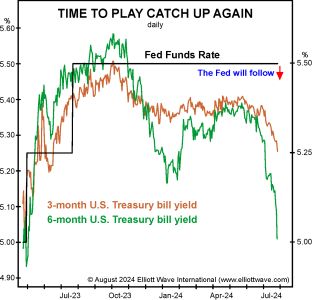By Elliott Wave International
Credit investors aren't worried about a thing. They sneer at the possibility of a recession. A slew of corporate defaults? Nah. Complacency is so extreme that Elliott Wave International's December Global Market Perspective warned that a tipping point might be at hand:
Two of the most important credit-market sentiment indicators in the United States point to extreme optimism. On November 8, investment-grade credit spreads (left chart below) narrowed to just 74 bps, their tightest level in nearly three decades. One week later, high-yield (i.e. junk) spreads fell to 253 bps, their tightest level in nearly two decades. The equivalent spreads in Europe have narrowed to their tightest levels since early 2022:

What do these extremes mean? As we discussed in March, investors buy riskier corporate debt (over treasuries) when they view the future optimistically, causing spreads to narrow. In contrast, they buy safer treasuries (over corporates) when they view the future pessimistically, causing spreads to widen. As shown, the three major financial crises over the past two decades reached their zenith as terrified investors sold corporate bonds indiscriminately.
Are credit spreads preparing for another blowout? A decade ago, EWI observed a compelling pattern in equities, whereby European stocks peaked "prior to major tops in the Dow" (Elliott Wave Financial Forecast, July 2013). The pattern was best exemplified by the FTSE 100, which peaked one month before the DJIA in 1987, seven months before the DJIA in 1990, two weeks before the DJIA in 2000, and three months ahead of the DJIA in 2007. Could Europe's credit markets be signaling similar trouble?
Credit spreads in key sectors have already started to widen. Plus, EWI's January Global Market Perspective shows a highly revealing 3.4-year cycle of U.S. corporate high-yield spreads which directly relates to the year – 2025. Get Global Market Perspective insights now by following this link.
Not ready to subscribe? Try a sample first. Read EWI's FREE highlights issue on Global Markets.
This article was syndicated by Elliott Wave International and was originally published under the headline Another Blowout Ahead for Credit Spreads?. EWI is the world's largest market forecasting firm. Its staff of full-time analysts led by Chartered Market Technician Robert Prechter provides 24-hour-a-day market analysis to institutional and private investors around the world.



